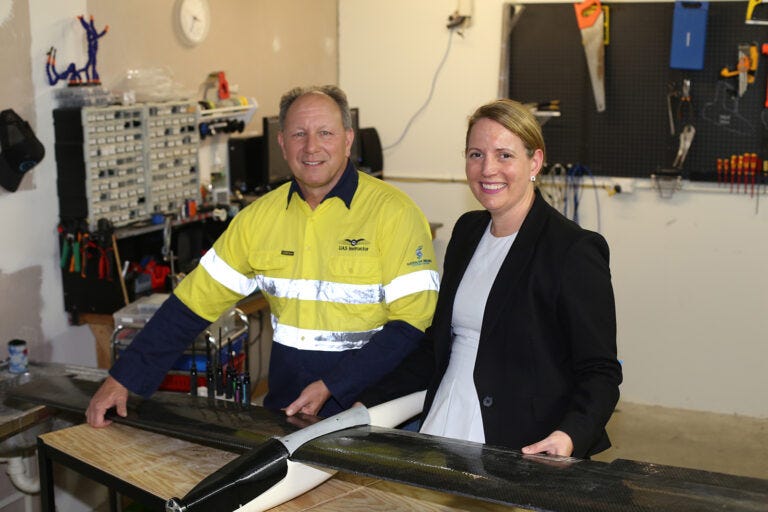Drones Planned for Weeks-Long Fights at 70,000 Feet
Australian battery technology company, drone developer and solar panel maker collaborate to create new drones

Three companies have teamed to develop and test Australian-made high altitude and low altitude (HALE) drones.
Battery technology company Li-S Energy, drone developer V-TOL Aerospace and solar panel maker Halocell are working together to leverage each company’s innovations to build a drone they say can fly at an altitude of 70,000 feet for weeks at a time – up to six times the flight time of current small-fixed wing drone aircraft.
Prototype drones will be equipped with Li-S Energy lithium sulfur batteries, Halocell perovskite solar cells and V-TOL’s Pegasis fixed-wing aircraft designs.

V-TOL Aerospace managing director Mark Xavier and Li-S Energy CFO Sarah Price with a very early prototype.
Lee Finniear, CEO of Li-S Energy, called the partnership one of international significance.
“We are bringing together three innovative Australian companies to build autonomous drones with wide-ranging capabilities,” he said. “This allows us to not only demonstrate the benefits of Li-S Energy cells in practical high-altitude aircraft, but potentially build a new sovereign capability for the Australian aviation industry.”
Mark Xavier, V-TOL Aerospace managing director, said he expects the collaboration to result in a family of “hi-tech drones, sensors and robots capable of operating from dawn till dusk and beyond.”
“All three partners are at the cutting edge of their respective technologies, and the combination of all three offers some exciting opportunities to test the limits of what is currently possible,” he said.
Halocell CEO Paul Moonie said adding the cells to drones will add an entirely new dimension to flight time and efficiency.
“Aerospace and aviation are key areas of focus for us moving forward, and this opportunity to partner with Li-S Energy and V-TOL is an important step for us,” Moonie said.
The drones are expected to work in several commercial applications including remote surveillance and security, environmental monitoring, digital farming, disaster response and relief, infrastructure inspections, remote delivery and logistics and research and exploration.
Like what you've read? For more stories like this on drones and emerging technologies, sign up for our free daily email newsletter to stay updated!
About the Author
You May Also Like
.jpg?width=100&auto=webp&quality=80&disable=upscale)
.jpg?width=400&auto=webp&quality=80&disable=upscale)






